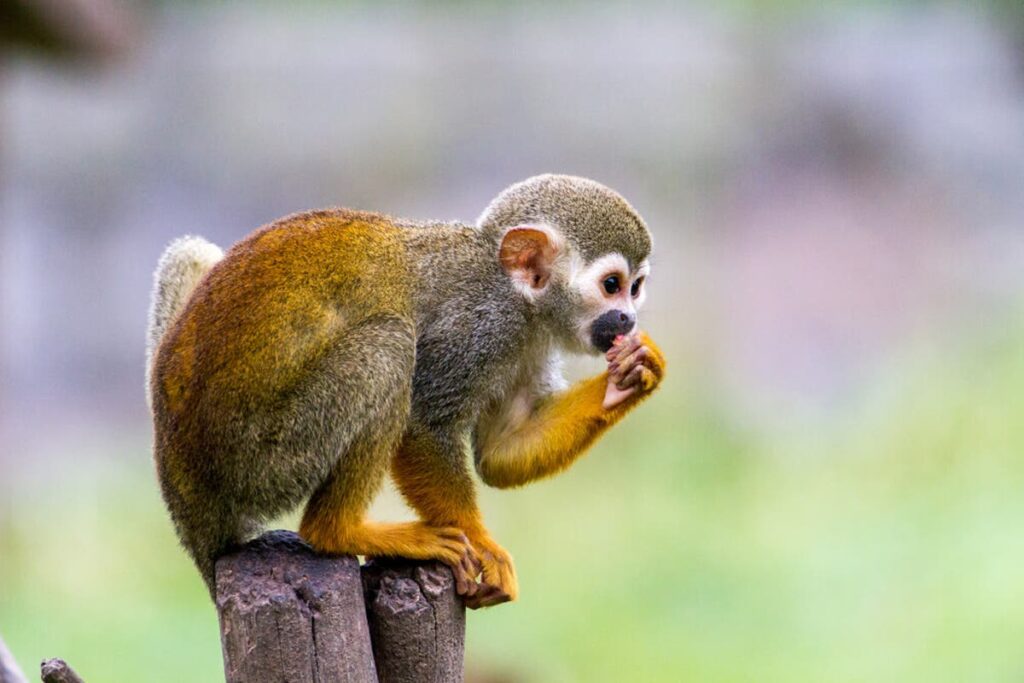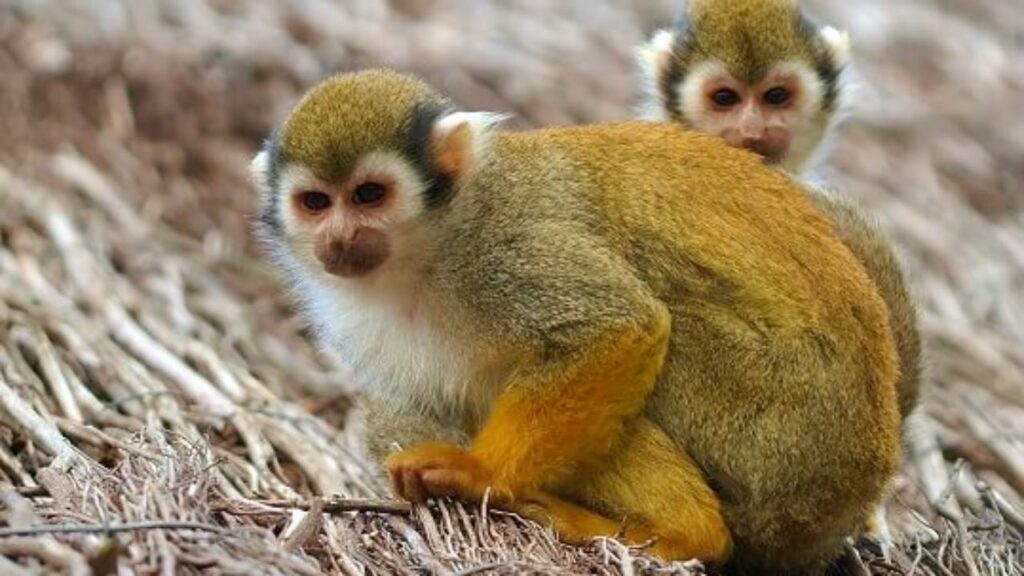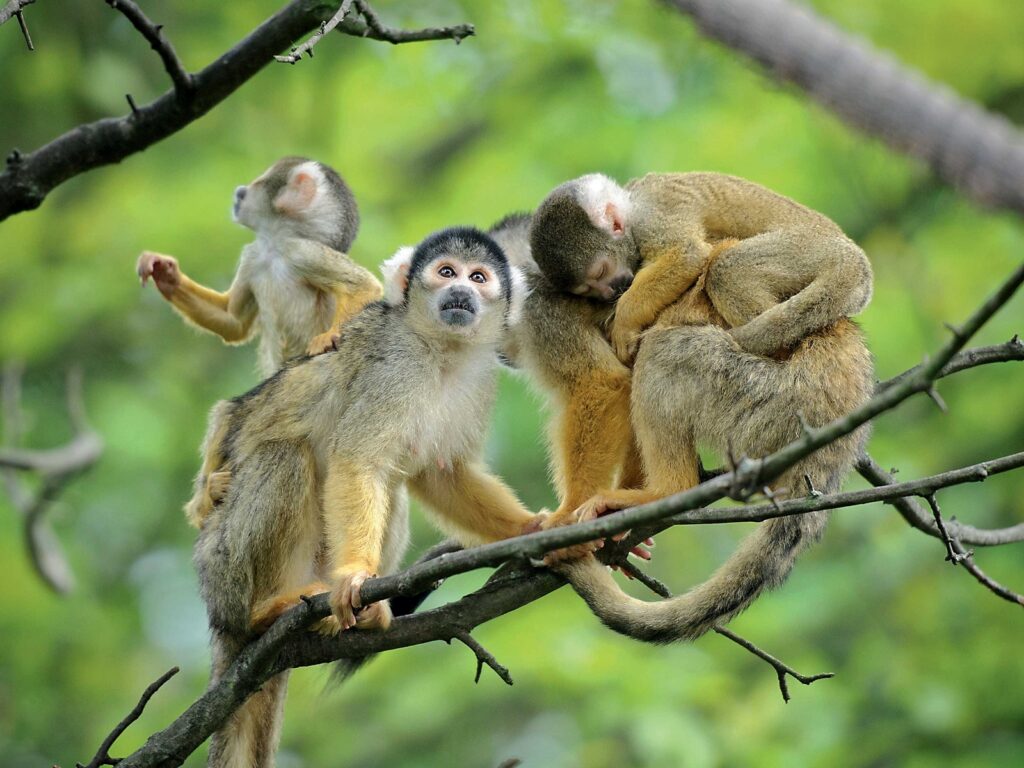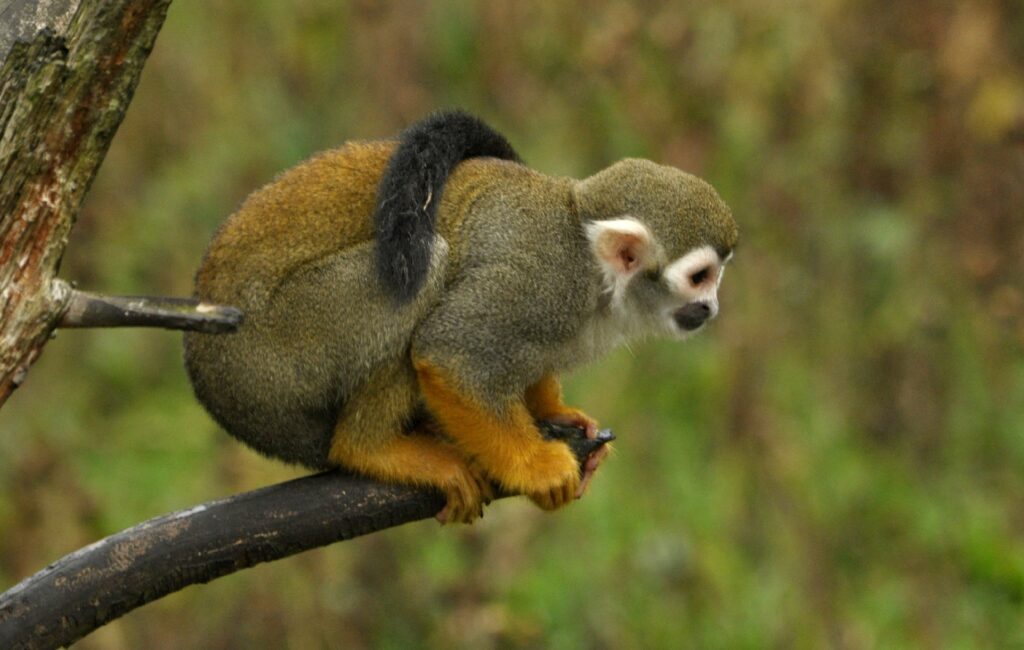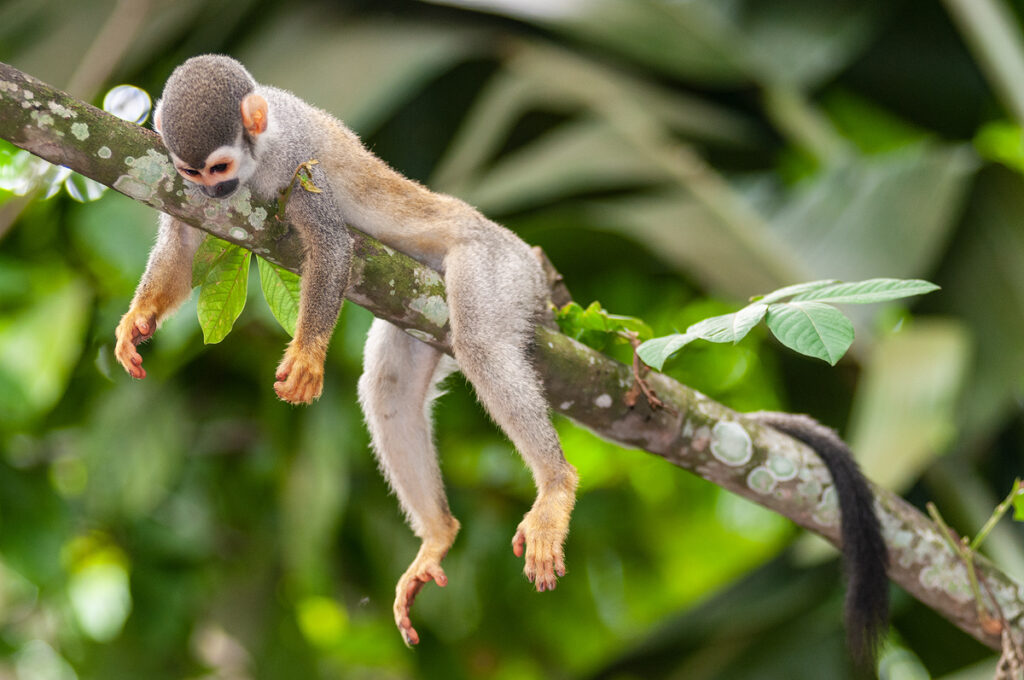The Squirrel Monkey is a tiny primate of the Cebidae family that is found in the tropical regions of the American continent. Despite their name they are not genetically related to squirrels, but they are well named because they are small, agile and enjoy jumping from tree to tree. You will be able to learn much more about the squirrel monkey by continuing to read this interesting article.
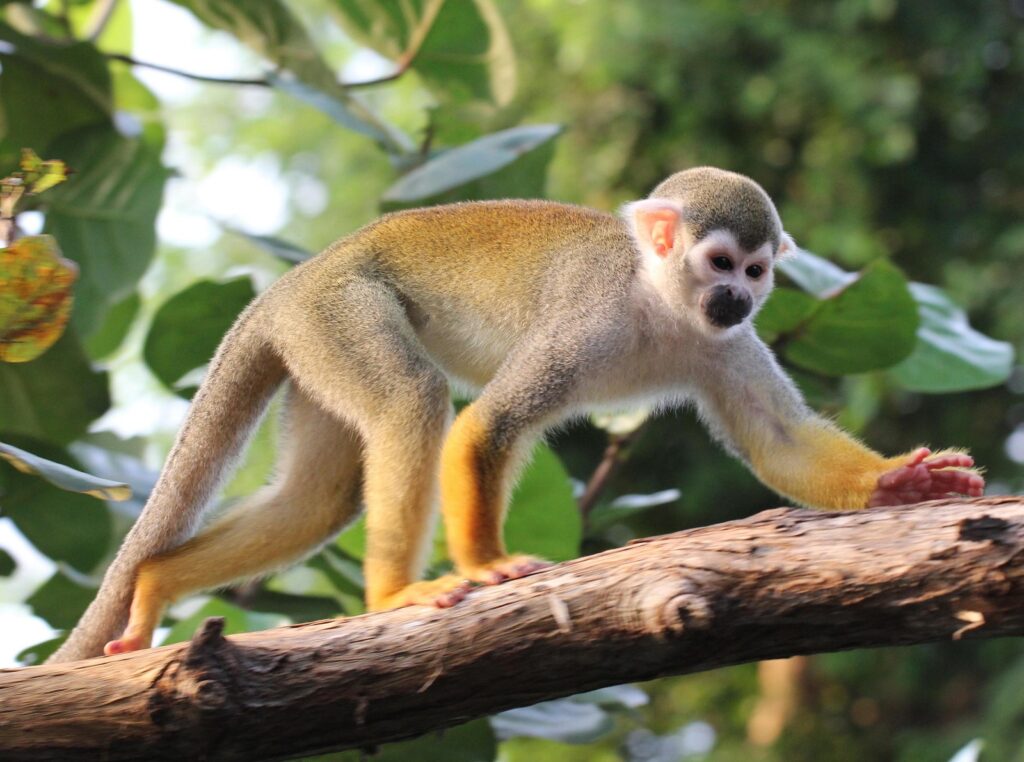
The Squirrel Monkey
The common squirrel monkey is an ape that inhabits the tropical region of the continent and is part of the Cebidae family. Its scientific name is Saimiri sciureus and, like all squirrel monkeys, it has an extensive tail, not prehensile, with a black tip. In its adulthood, its body reaches 62 to 82 centimeters from head to tail, and its weight ranges from 0,55 to 1,25 kilograms.
It is characteristic for a white facial mask on the face, in which its black (or dark brown) snout stands out. Like the species Saimiri oerstedii and Saimiri ustus (and in contrast to the other species of the genus), its facial mask forms a “gothic” arch above the eyes in the shape of a white V.
Common Names and Etymology
Saimiri comes from the Tupi language, a dialect in which "sai" indicates various species of monkeys and "mirim" means small. Sciureus means "squirrel" in Latin. In common speech it is known as marmoset, squirrel monkey or friar monkey. It is also referred to as "Vizcaino", "mico soldier", "marmoset friar", "fraile", "little friar", "macaco de cheiro", "saimiri", "sai mirím" or "chichico", despite the fact that these denominations They are primarily used on Colombian soil.
Taxonomy and Phylogeny
The squirrel monkey is one of the 5 varieties recognized until 2014 as part of the genus Saimirí. It was initially reviewed by Carlos Linnaeus in 1758. Currently 4 subspecies are recognized:
- Saimiri sciureus albigena
- Saimiri sciureus cassiquiarensis
- Saimiri sciureus macrodon
- Saimiri sciureus sciureus
Due to the similarity between all the primates of the genus Saimiri, it was admitted that there were only two species (S. oerstedii and S. sciureus), until the examination of mitochondrial and nuclear DNA made it possible to determine 5 species, however, such an organization is still subject to controversy. An alternate taxonomy suggested by Thorington Jr. (1985) would incorporate the subspecies albigena, macrodon, and ustus as part of Saimiri sciureus, with additional subspecies S. sciureus boliviensis, S. sciureus cassiquiarensis, and S. sciureus oerstedii.
In addition to the above, two phylogenetic analyzes carried out in 2009 ensure that S. s. sciureus would be more related to S. oerstedti than to S. s. albigena and with all and each of the others, until now considered subspecies, of S. sciureus, including S. collinsi from Marajó Island and southeastern Amazonia. They also propose the separation of S. s. sciureus and a variety that would become Saimiri cassiquiarensis with subspecies S. cassiquiarensis albigena.
Another suggested alternative is the division of all the Colombian subspecies of S. sciureus, transforming them into species (S. albigena, S. cassiquiarensis and S. macrodon). From a phylogeographic perspective, the researchers determine that the genus Saimiri did not spread from the northwest of the continent, but from the west, so that S. sciureus and S. oerstedii became different as a consequence of the migration to the north (northeast and northwest, respectively).
A phylogenetic study released in 2011 confirmed that S. s. sciureus diverged more recently from S. oerstedti than from which other subspecies of S. sciureus have been considered. On the other hand, a 2014 morphological and phylogenetic investigation determined that Saimiri collinsi (Osgood 1916), previously held as a subspecies S. sciureus collinsi, should be divided as a distinct species. The S. collinsi variety can be distinguished with the naked eye by its yellow crown, while that of S. sciureus is grey.
Additionally, a 2014 biogeographic and phylogenetic analysis confirmed the hypotheses of previous DNA analyses, according to which S. boliviensis was the species that first separated from the rest of the genus and S. sciureus sciureus forms a monophyletic clade, sister variety of S. oerstedii. On the other hand S. s. macrodon is made up of three paraphyletic clades, the initial one being sister to S. s. cassiquiarensis; the second diverged early from that set and from S. s. albigenic; the latter is a brother of S. c. albigenous
Anatomy and Physiology
The squirrel monkey is very similar to the other species of the genus. They are all arboreal apes, small and light, with low hair and slender in appearance. It has a white mask on the face, a black snout, a gray crown and the ears and throat are also white. Its body mass (head, back, sides, outer limbs, and most of the tail) is olive-gray with a hint of yellowish. The back is usually cinnamon-yellowish, and the belly is white or yellowish-white, while the last third of its tail is black.
It can be differentiated from some other species of the genus (although not from all of them) by the existence of a “gothic” arch (like S. oersdesti and S. ustus) that is constituted in the mask, which achieves greater elevation over the eyes, forming a black V on the forehead (or two white Λs above each eye), and which is distinguished from the “Romanesque” arch of the other varieties, S. boliviensis and S. vanzolinii, caused by a much more complex mask. blunt above the eyes, which forms two semicircles above each of them.
When they are born, their weight is between 80 and 140 grams, and they can weigh between 0,554 and 1,250 kilograms in adulthood. Other sources, less specific in terms of species, refer to 0,649 to 1,25 kilograms and from 700 to 1.100 grams for males and 0,649 to 0,898 kilograms and 500 to 750 grams for females.
Likewise at birth, the length of the body and head is 13 to 16 centimeters, reaching 26,5 and 37 centimeters in adulthood. The tail reaches 36 to 45,2 centimeters in length, being longer than the body, despite not being prehensile. Its movement is primarily quadrupedal, leaning on branches one or two centimeters in diameter.
Distribution and habitat
The squirrel monkey resides in a large number of different environments. It is found, among others, in gallery forests, low-roof sclerophyllous forests, hillside forests, palm groves (primarily Mautitia flexuosa communities), rainforests, seasonally flooded and upland forests, and mangroves. Being a generalist, it can subsist more easily than many other varieties of apes in degraded environments.
It can be found in a huge variety of environments, as it can even survive in the remaining forests in areas where human activity has altered its natural habitat, provided there is a convenient supply of fruits and insects. Due to its ability to resist in human-altered environments, it is not considered a threatened species. It is abundantly hunted for the pet market, an essential factor of threat to the species. A subspecies from Colombia, Ss albigena, is threatened by high rates of deforestation.
Saimiri sciureus sciureus, probably the subspecies with the largest distribution range, is found in Guyana, Suriname, French Guiana and the Brazilian Amazon, east of the Branco and Negro rivers north of the Amazon river, up to Amapá There are no records that indicate its permanence above 100 meters above sea level.
Saimiri sciureus albígena, a subspecies native to Colombia, is found in the gallery forests of the Colombian Eastern Plains and at the foot of the eastern Andean peaks, in the departments of Casanare, Arauca, Meta and Huila. Its distribution extends to undetermined limits to the north along the Magdalena River and to the east in the departments of Arauca and Casanare. They have been recorded from 150 meters above sea level, being in Huila up to 1.500 meters above sea level.
Saimiri sciureus cassiquiarensis is found in the upper Amazon and in the Orinoquia regions, in Brazil, in the state of Amazonas, north of the Solimões river and west of the Demini and Negro rivers, from where it spreads towards the basin. of the Orinoco-Casiquiare, in Venezuela. To the west, it reaches the Colombian east, between the Apaporis and Inírida rivers, in the departments of Vaupés, Guaviare and Guainía.
Saimiri sciureus macrodon is found in the upper Amazon, further west than Sscassiquiarensis. In Brazil, in the state of Amazonas between the Juruá and Japurá rivers, in Colombia, south of the Apaporis river spreading to the east of Ecuador, in the entire Ecuadorian Amazon and in the Andean foothills, and reaching up to the departments from San Martín and Loreto, in Peru, to the north bank of the Marañón-Amazonas rivers. In Ecuador they have been recorded at heights of up to 1.200 meters above sea level.
Saimiri collinsi can be found in the southern basin of the Amazon River, from the Tapajós River in Maranhão and Marajó. Considering this as a species, it is established that S. sciureus is not located south of the Amazon River. Additionally, mentions about the presence of S. sciureus in areas of eastern Bolivia should be dispensed with, since genetic analyzes have shown that only Saimiri boliviensis is found in Bolivia. Saimiri ustus can reach the Brazilian shores of Bolivian-Brazilian border rivers, which are insurmountable for the species.
Squirrel Monkey Behavior
They are diurnal habits (as well as all members of the Cebidae family except Aotus), and primarily arboreal, however, it is common to see them lower to the ground and walk more or less long distances. They constitute groups that, subject to the environment in which they are found, they can have 10 or up to 500 specimens, all of them made up of several males and several females, to which the young and infants are added.
It does not show territorial behavior, and usually avoids conflicts by getting with other groups. It frequently uses the margins of the forests and can easily live in isolated fragments, a consequence of deforestation. Like most small monkeys, it shows great activity in the lower and middle levels of the forest.
Diet
Research carried out on Saimiri sciureus shows it to be a primarily frugivorous-insectivorous species. They eat fruits, berries, nuts, flowers, buds, seeds, leaves, gums, insects, arachnids and modest vertebrates, however, their short digestive tract means that they are more adapted to using insects than plants . In general, Saimiri usually forages and consumes mostly fruit in the early morning hours, narrowing its foraging and opting for insects as the day progresses.
It is conjectured that the diet of Saimiri sciureus is very similar to that of Saimiri boliviensis, which is better identified. In a study in southern Peru, S. boliviensis spent 78% of its feeding time consuming fruits up to 1 centimeter in diameter. The height to which it climbed for food varied from 18 to 32 meters, averaging 27 meters. S. boliviensis, according to this study, fed on 92 varieties of fruit, which are part of 36 families. The most important were:
- Moraceae (22 varieties)
- Annonaceae (8 varieties)
- Leguminosae (7 varieties)
- Sapindaceae (5 varieties)
- Flacourtiaceae and Myrtaceae (4 varieties)
- Ebenaceae and Menispermaceae (3 varieties).
The animal part of their diet was primarily made up of invertebrates (on numerous occasions larvae and pupae), although it also included birds, lizards and frogs, and this species is estimated to be an extraordinary predator of invertebrates.
Social structure
Squirrel monkeys constitute larger aggregations than any other ape species in the tropical region of the continent. Groups of 25 to 45 have been recorded with enormous variations depending on the environment in which they are located. These groups are made up of several males and several females, and 65% of infants or subadults, 29% of adult females have been reported. and 6% of adult males.
In an investigation carried out under captive conditions in Florida, it was possible to determine the separation of the groups into subgroups of males and females, with greater union within the groups of females (apparent by greater physical proximity). Likewise, the presence of rigorous linear hierarchies is cited, both within the subgroup of males and that of females, despite the fact that such ranking was much more evident among males.
It should be mentioned that, in the wild, females are the gender that most tends to remain in their native territory, while males are the ones that spread out to search for new groups. Supposedly, Saimiri is known for a low territoriality. Several cases have been recorded; in Monte Seco (in the Colombian plains), in Barquetá (Panama) and on the island of Santa Sofía (next to Leticia, Colombia); overlapping of the territories of two groups without there being any kind of conflict, simply, the groups would avoid contact.
Reproduction
All Saimiri monkeys show a polygamous mating system, however, one or two males copulate more frequently than the other members of the group. In the wild and in certain laboratories, Saimiri exhibits an evident reproductive seasonality, which seems to be more linked to the increase and decrease in rainfall than to temperature. This season would take place from August to the beginning of October, and the births would be synchronized in order to reduce the chances of death by predation.
Males reach sexual maturity at 2,5 to 4 years and females at four years. The reproductive activity of the males would be stimulated, to a certain extent, by olfactory and other types of traces on the part of the females. These, for their part, are inclined to have a certain predilection for males that gain more weight in the two months prior to the mating season. Throughout the mating season, the accumulation of fat in the males is frequent, particularly around the shoulders.
The gestation process lasts five and a half months, after which a single calf is born. Births occur primarily between February and April, the season of profusion of arthropods. In a birth registered at the Japan Monkey Center, labor lasted approximately 1 hour 29 minutes, despite the fact that the last 11 minutes the baby had already climbed on the mother's back and it was only waiting for the placenta to emerge, which it used as food.
The first two weeks the young are sleeping and feeding primarily and in constant contact mainly with their mother. After the first 2 to 5 weeks they begin to distance themselves from the mother and to be carried by other members of the group. The young are weaned at six months.
Relationship with Other Species
The squirrel monkey is a diminutive primate with numerous potential predators. They produce alert vocalizations at every opportunity they see, among others, large birds, snakes, tayras or ulamas (Eira barbara), felids or canids. The falcon Harpagus bidentatus usually moves in the vicinity of aggregations of this primate, eating the insects that are scared away by the foraging activities of the apes. The relationship between Saimiri sciureus and Cebus apella is frequent, it has even been seen that a solitary individual of any of the two species will search for and stay with groups of the other.
The two species will usually continue together after meeting on a fruit tree, and the slower-moving pregnant females of Saimiri sciureus tend to lag behind the slower Cebus. Links have also been reported between Saimiri and Alouatta, and between Saimiri and Cacajao calvus rubicundus. In this last case, reciprocal games and grooming have been reported, although also fights.
Squirrel Monkey Conservation
The most important threat to the species is the degeneration of its habitat, due to its high need for space. They are not usually hunted, despite the fact that (mainly in Colombia and Ecuador) they are used to trapping them to sell them in the pet market.
H.H. albigena, above all, is seriously threatened by the high rate of deforestation in the Colombian Llanos, which leads to the fractionation, degradation and loss of its environment. An article from 2009 stated that, from then on, the red list of the International Union for Conservation of Nature (IUCN) classified it as "threatened".
The Squirrel Monkey, Victim of Loneliness
There is no greater punishment for a squirrel monkey Saimiri sciureus than forcing it to lead an existence apart from its peers. Accustomed to spending time in large herds of forty to fifty specimens, this species of ape does not tolerate loneliness. The modest, active and playful apes, called marmosets despite not being so, are extracted from the Amazon or the foothills of the plains and sold as pets in markets and city streets.
After overcoming several routes, 39 squirrel monkeys that were separated from their habitat, were able to form families from a distance in which unity stands out. Each of them arrived at the World Society for the Protection of Animals (WSPA) site from different areas and experienced different conditions of captivity. Some were rescued from animal traffickers and others handed over by their owners, who bought them for up to 30 pesos.
As of October 1992, some 39 friar or friar monkeys, as they are popularly known, have arrived at the WPSA in Bogotá. Seven perished and 19 were released in groups in the foothills of the Llanos and in Villavicencio. The other 13 form a large family and await their release in a few days, when they enjoy better physical, mental and psychological conditions; the latter as a product of the isolation to which they were subjected.
They have a Leader
An adult monkey is responsible for inspecting, sniffing, and approving of new guests. In the immediate vicinity of this dominant monkey the others congregate. In such an event, all that is discernible is a confusion of hands, heads, and tails embracing each other. They have all adapted to her new family, only a female who since she was little was only surrounded by humans was afraid since she did not know those of her species. They are very dynamic as they jump and run constantly throughout the 15 or 20 years they live.
The WSPA project is to rescue them and reintroduce them to wild populations, for which they intend to form socially solid groups as part of the plan for their rehabilitation as a species. Process that will increase the chances of subsistence because the unit of the squirrel monkeys is essential for the tasks of socialization, learning and searching for food. In South America, this monkey with short, thick and smooth hair is distributed from Colombia to Paraguay.
The squirrel monkey, like all wild varieties, is a victim of animal trafficking. It is also at risk of becoming extinct due to the deforestation of the primary and secondary forests in which it lives. This is the case of Central America, a region in which a subspecies of this monkey is at serious risk of extinction due to the devastation of its habitat.
South American Primates
Cebids and marmosets are considered to be the monkeys of America. To differentiate them from those of the Old World, it is enough to see their nose, since the Americans have rounded and widely separated nostrils, while those of Africa and Asia have them somewhat separated and point downwards. In Colombia there are 22 varieties of primates distributed in two main families: marmosets and cebids. Squirrel monkeys are part of the cebids.
In contrast to other species of their family, squirrel monkeys do not have a prehensile tail, that is, they do not have the adaptation to support themselves with it. All these creatures are victims of researchers, who use them in laboratory experiments, or of traffickers, who market them as pets. The squirrel monkey was one of the species that sold the most, since in four years 173 thousand squirrel monkeys were sent to the United States. Currently, imports of the species are prohibited.
Wild animals should not be pets
There are various reasons why it is advised that squirrel monkeys, and in general, wild animals, not be used as pets, for their well-being and that of their owners. Owners usually do not know what food is suitable for their little animals. Most of the time they provide them with bread and milk, and if they know the recommended diet, which in certain cases is specialized, it is not available in the cities, such as seeds, leaves, fruits, stems, etc.
Another reason is that man places himself in danger of acquiring affections. Numerous animal species transmit dangerous diseases. On the other hand, it is an irremediable ecological damage, since wild animals usually do not reproduce in captivity. In addition to this, those who buy wildlife harm their populations, increasing the chances that they will become extinct. And, finally, the animals do not become happy since they are altered both mentally and psychologically.
The Scandalous Experiment with Squirrel Monkeys
With only a year of existence, the squirrel monkeys had already developed a nicotine addiction. Enclosed in devices that restricted their movements, the animals were taught to move a lever that delivered doses of nicotine directly into the bloodstream. Thus they came to live for three years: isolated, suffering from vomiting, diarrhea and trembling from addiction, when they did not perish directly in the process.
Four months after it was denounced as torture by the ethologist and famous ape conservationist, Jane Goodall, the United States government ordered the end of the experiment that the United States Food and Drug Administration (FDA) had been carrying out since 2014. The purpose of the state project was to find out the consequences of tobacco addiction in adolescents using individuals from Saimiri sciurea as a model.
“I am convinced that most Americans would be shocked to learn that they pay for such abuses with their taxes,” Goodall said in a September letter to FDA Commissioner Scott Gottlieb. Following an investigation into the welfare of the animals, the FDA ruled to close the study and began implementing changes to regulations on animal experiments in the United States.
From Addiction and Death to the Sanctuary
Beginning in 2014, research undertaken by the National Center for Toxicological Research (NCTR) calculated the degree of addiction to nicotine according to the doses supplied. According to Goodall, the tests carried out on squirrel monkeys were "appalling" not only because of the addiction stimulated, but also because of the confinement to which these "social and talented" animals were subjected, he said.
However, what ended up arousing the irritation of animal defense groups was the death of four monkeys in recent months. According to the FDA investigation, three of the primates perished after anesthesia was administered to implant catheters. The fourth died of stomach inflammation "for reasons that are not clear," they announced. A fifth ape, named after Patsie, nearly died on July 20, 2017, also after being given anesthesia.
In a message published on Friday, July 21, Gottlieb stated that they recognized "various problems" in the project, including "repeated imperfections" related to animal welfare and "a general lack of adequate monitoring that could lead to similar problems. for other protocols and processes. After the closure of the investigation, the FDA resolved that 26 monkeys be sent to a sanctuary. But the scandal did not end there.
Future Changes
In the aforementioned statement, Gottlieb considered that animal research should "be strengthened in certain areas of importance." To that end, he announced "additional actions to ensure that any issues related to current processes and methods are met and determine additional tasks that the agency has to perform to protect the welfare of animals in our custody."
In addition to the extension of the investigation that was carried out in the NCTR to the other FDA delegations that study animals, an Animal Welfare Council was formed to monitor such activities and facilities, among other provisions. Studies with animals and especially with primates is a controversial issue in the US and worldwide. From the scientific point of view, it is taken for granted that even animals cannot be replaced by computational or in vitro models when it comes to investigating issues such as obtaining drugs and treatments for diseases.
Activists, in contrast, fight for the industry to achieve substitution or minimize the use and suffering of animals. As of 2011, the National Institutes of Health (NIH) of the United States, for example, abandoned the financing of new biomedical research with primates and in 2015 they began to send to sanctuaries those specimens that still remained in their laboratories. NIH director Francis Collins backed the decision, saying apes are "our closest relatives in the animal kingdom" and deserve "special place and respect."
Other items we recommend are:

